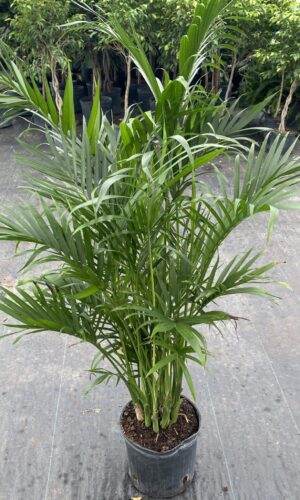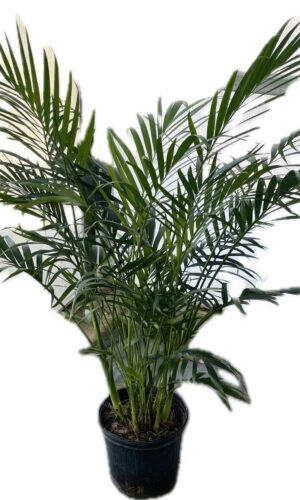The Cat palm, also called the Cascade or Cataract palm, is native to southeastern Mexico and resembles the inexpensive Areca palm and the very pricey Kentia palm. Indoors the plant grows slowly, eventually reaching a height of 4-6ft.
Cat palms need bright, indirect light but no direct sun.
Cat palms like moist but not soggy soil at all times. Fronds turn yellow if the soil gets too dry. Salty water or water containing chemicals such as fluoride causes leaf tip burn; over watering causes entire fronds to turn brown.
Palms like heat but too much dry heat causes leaf damage. Avoid placing palms in drafts, in front of heaters or air conditioners. Cat Palmsprefer 70°- 80°F (21.1°-26.7°C) during the day and no lower than 45°F(7.2°C) at night. Avoid placing a Cat Palm near heaters.
Lack of sufficient humidity is another reason Cat palms develop brown tips. Ideally the room should have about 55% humidity, but this is rarely the case in our homes. You can place a humidifier in the room or place the palm on a wet gravel tray; just be sure the plant sits on the gravel and not in the water.
Spider mites, scale, Mealy Bugs, and ants can all be a problem.
Helminthosporium, or Leaf Spot is a fungal disease that affects the leaves of a Cat palm. It appears as a reddish-brown lesion between one-eighth to one-fourth inches in length.
The Cat palm requires a potting soil that drains quickly. If you soil is heavy and clay-like, try adding some peat moss or sand.
Palms like to be root- bound. Do not re-pot a Cat palm until the roots have filled the existing container.
Cut off yellow or brown fronds quickly. Brown leaf tips can be trimmed with a wet scissors; this usually prevent additional browning or yellowing of the leaf tips.
Most palm plants are listed as Clean Air Plants.
Cat palms are non- poisonous


